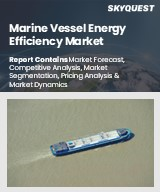
|
시장보고서
상품코드
1699305
해양 에너지 시장 기회, 성장 촉진요인, 산업 동향 분석, 예측(2025-2034년)Marine Energy Market Opportunity, Growth Drivers, Industry Trend Analysis, and Forecast 2025-2034 |
||||||
세계의 해양 에너지 시장은 2024년에 21억 달러에 이르렀고, 2025년부터 2034년까지 연평균 복합 성장률(CAGR) 8.1%를 나타낼 것으로 예측되며 강력한 성장이 예상됩니다.
세계가 점점 깨끗한 에너지원으로 이동하는 가운데 해양 에너지 기술은 그 지속가능성, 신뢰성, 카본실적를 삭감하는 능력에 의해 지지를 모으고 있습니다.

에너지 변환 시스템, 혁신적인 소재, 최적화된 전개 전략의 진보는 효율을 높이고 비용을 낮추고 해양 에너지를 기존의 화석 연료를 대체할 수 있는 것으로 해 왔습니다. 해양 에너지 기술을 한층 더 세련시켜, 발전, 해수 담수화, 공업 프로세스에의 새로운 응용을 가능하게 하고 있습니다.
| 시장 범위 | |
|---|---|
| 시작 연도 | 2024년 |
| 예측 연도 | 2025-2034년 |
| 시작 금액 | 21억 달러 |
| 예측 금액 | 42억 8,000만 달러 |
| CAGR | 8.1% |
해양 에너지 시장은 해양온도차발전(OTEC), 파력발전, 조력발전, 염분농도 구배발전(SGP) 등 에너지의 유형에 따라 분류됩니다. 밀도가 높기 때문에 조류가 비교적 약한 지역에서도 상당한 발전이 가능하며 대규모 재생 가능 에너지 발전 프로젝트에 적합합니다.
용도의 관점에서 보면 해양 에너지는 발전, 담수화, 다양한 산업 프로세스에 이용되고 있습니다.수입 화석 연료에 대한 전력 생산 의존도가 높아지면서 여러 국가가 온실가스 배출을 줄이면서 에너지 안보를 강화하기 위해 해양 기반 솔루션을 모색하고 있습니다.
북미의 해양 에너지 시장은 강력한 성장이 전망되고 있으며, 2024년 CAGR은 9.3%였습니다. 첨단 해양 에너지 기술에 대한 민간 부문의 투자도 증가 추세에 있으며, 업계의 성장 가능성을 더욱 확고하게 하고 있습니다.
목차
제1장 조사 방법과 조사 범위
- 시장의 정의
- 기본 추정과 계산
- 예측 계산
- 1차 조사와 검증
- 시장 정의
제2장 주요 요약
제3장 업계 인사이트
- 업계 에코시스템
- 규제 상황
- 업계에 미치는 영향요인
- 성장 촉진요인
- 업계의 잠재적 위험 및 과제
- 성장 가능성 분석
- Porter's Five Forces 분석
- PESTEL 분석
제4장 경쟁 구도
- 서론
- 전략 대시보드
- 혁신과 지속가능성의 전망
제5장 시장 규모와 예측 : 유형별(2021-2034년)
- 주요 동향
- 파력 에너지
- 조력 에너지
- 해양 열 에너지 변환(OTEC)
- 염분 구배 발전(SGP)
제6장 시장 규모와 예측 : 용도별(2021-2034년)
- 주요 동향
- 발전
- 담수화
- 기타
제7장 시장 규모와 예측 : 지역별(2021-2034년)
- 주요 동향
- 북미
- 미국
- 캐나다
- 유럽
- 프랑스
- 스페인
- 영국
- 노르웨이
- 아시아태평양
- 중국
- 인도
- 한국
- 세계 기타 지역
제8장 기업 프로파일
- BioPower Systems
- Carnegie Clean Energy
- CorPower Ocean
- Minesto
- Marine Energy Group
- Nova Innovations
- Ocean Renewable Power Company
- Orbital Marine Power
- SSE Renewables
- SINN Power
The Global Marine Energy Market reached USD 2.1 billion in 2024 and is set for robust growth, projected to expand at a CAGR of 8.1% between 2025 and 2034. As the world increasingly shifts toward cleaner energy sources, marine energy technologies are gaining traction due to their sustainability, reliability, and ability to reduce carbon footprints. The rising demand for stable and climate-resilient energy solutions is a significant driver for market expansion. Governments and private sector entities are ramping up investments in marine power projects, recognizing their potential to provide a steady and renewable energy source.

Advancements in energy conversion systems, innovative materials, and optimized deployment strategies are enhancing efficiency and lowering costs, making marine energy a viable alternative to traditional fossil fuels. Countries with extensive coastlines and high wave energy densities are particularly well-positioned to harness this resource. Ongoing research and development efforts are further refining marine energy technologies, unlocking new applications in power generation, desalination, and industrial processes. The sector is also benefitting from policy incentives, grants, and subsidies that encourage adoption and commercialization. Additionally, strategic collaborations between industry players and government bodies are fostering innovation and accelerating deployment.
| Market Scope | |
|---|---|
| Start Year | 2024 |
| Forecast Year | 2025-2034 |
| Start Value | $2.1 Billion |
| Forecast Value | $4.28 Billion |
| CAGR | 8.1% |
The marine energy market is categorized by energy types, including ocean thermal energy conversion (OTEC), wave energy, tidal energy, and salinity gradient power (SGP). Among these, tidal energy is projected to dominate, reaching USD 2.8 billion by 2034. Its high energy density enables substantial power generation even in areas with relatively low tidal currents, making it a preferred choice for large-scale renewable energy projects. Governments worldwide are implementing favorable policies, including subsidies and grants, to boost tidal energy adoption and drive market penetration.
From an application perspective, marine energy is utilized for power generation, desalination, and various industrial processes. The power generation segment accounted for a dominant 75.5% market share in 2024, driven by increasing global commitments to achieving net-zero emissions by 2050. The rising dependence on imported fossil fuels for electricity generation has encouraged several nations to explore marine-based solutions to enhance energy security while reducing greenhouse gas emissions. Investments in marine energy infrastructure are expanding, particularly in regions with abundant tidal and wave energy resources, contributing to higher generation capacities and widespread adoption.
North America marine energy market is positioned for strong growth, with a projected CAGR of 9.3% in 2024. The US marine energy sector alone was valued at USD 78.2 million in 2024, driven by ambitious renewable energy targets set by multiple states. The US Navy is exploring marine power solutions for coastal installations and remote operations, adding momentum to market expansion. Private sector investments in cutting-edge marine energy technologies are also on the rise, further solidifying the industry's growth potential. As a result, North America is emerging as a key region for marine energy advancements, with increasing deployment of wave and tidal power systems enhancing the renewable energy mix.
Table of Contents
Chapter 1 Methodology & Scope
- 1.1 Market definitions
- 1.2 Base estimates & calculations
- 1.3 Forecast calculation
- 1.4 Primary research & validation
- 1.4.1 Primary sources
- 1.4.2 Data mining sources
- 1.5 Market definitions
Chapter 2 Executive Summary
- 2.1 Industry synopsis, 2021 – 2034
Chapter 3 Industry Insights
- 3.1 Industry ecosystem
- 3.2 Regulatory landscape
- 3.3 Industry impact forces
- 3.3.1 Growth drivers
- 3.3.2 Industry pitfalls & challenges
- 3.4 Growth potential analysis
- 3.5 Porter's analysis
- 3.5.1 Bargaining power of suppliers
- 3.5.2 Bargaining power of buyers
- 3.5.3 Threat of new entrants
- 3.5.4 Threat of substitutes
- 3.6 PESTEL analysis
Chapter 4 Competitive landscape, 2024
- 4.1 Introduction
- 4.2 Strategic dashboard
- 4.3 Innovation & sustainability landscape
Chapter 5 Market Size and Forecast, By Type, 2021 – 2034 (USD Million & MW)
- 5.1 Key trends
- 5.2 Wave energy
- 5.3 Tidal energy
- 5.4 Ocean thermal energy conversion (OTEC)
- 5.5 Salinity Gradient Power (SGP)
Chapter 6 Market Size and Forecast, By Application, 2021 – 2034 (USD Million & MW)
- 6.1 Key trends
- 6.2 Power generation
- 6.3 Desalination
- 6.4 Others
Chapter 7 Market Size and Forecast, By Region, 2021 – 2034 (USD Million & MW)
- 7.1 Key trends
- 7.2 North America
- 7.2.1 U.S.
- 7.2.2 Canada
- 7.3 Europe
- 7.3.1 France
- 7.3.2 Spain
- 7.3.3 UK
- 7.3.4 Norway
- 7.4 Asia Pacific
- 7.4.1 China
- 7.4.2 India
- 7.4.3 South Korea
- 7.5 Rest of World
Chapter 8 Company Profiles
- 8.1 BioPower Systems
- 8.2 Carnegie Clean Energy
- 8.3 CorPower Ocean
- 8.4 Minesto
- 8.5 Marine Energy Group
- 8.6 Nova Innovations
- 8.7 Ocean Renewable Power Company
- 8.8 Orbital Marine Power
- 8.9 SSE Renewables
- 8.10 SINN Power



















